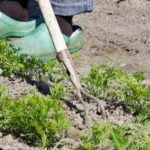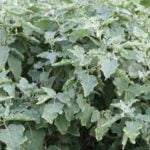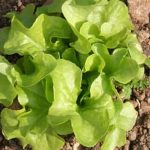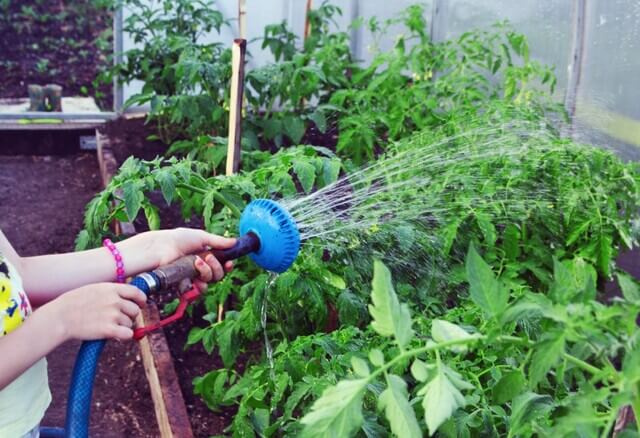Container vegetable gardening basics are a great way to grow your own produce, even if you don’t have a lot of space. In this article, we will explore the essentials of container vegetable gardening, from choosing the right containers and location to selecting the best vegetables and dealing with pests and diseases. Whether you’re a beginner or an experienced gardener, this guide will help you create a thriving container garden.
When it comes to container vegetable gardening, there are several factors to consider in order to ensure success. From the type of containers and soil to the selection of vegetables and proper maintenance, each aspect plays a crucial role in the health and productivity of your garden.
In this comprehensive guide, we will cover everything you need to know about getting started with container vegetable gardening. By the end of this article, you’ll be equipped with the knowledge and practical tips to create a bountiful garden full of fresh, home-grown produce right at your doorstep.
Choosing the Right Containers for Your Vegetable Garden
When it comes to container vegetable gardening basics, choosing the right containers for your vegetable garden is crucial for the success of your plants. The type and size of the containers you choose will directly impact the health and growth of your vegetables. Here are some important factors to consider when selecting containers for your vegetable garden.
Material
The material of the container plays a significant role in determining the health of your plants. Containers can be made from plastic, terracotta, wood, or fabric. Plastic containers are lightweight, affordable and retain moisture well. Terracotta pots are porous and allow for good air circulation but can dry out quickly. Wooden containers are durable but may rot over time. Fabric pots provide excellent drainage and root aeration.
Size
The size of the container also matters when it comes to growing vegetables. Larger vegetables like tomatoes or peppers require larger containers with at least 5 gallons of soil capacity per plant, while smaller plants like lettuce or herbs can thrive in smaller pots.
Drainage
Proper drainage is essential for container vegetable gardening. Ensure that your containers have drainage holes at the bottom to prevent waterlogging, which can lead to root rot. If your chosen container doesn’t have drainage holes, you can drill them yourself before planting.
By considering these factors when choosing the right containers for your vegetable garden, you’ll set yourself up for success in container vegetable gardening basics. Each type of material and size has its pros and cons, so make sure to choose the best option based on the specific needs of the vegetables you plan to grow.
Selecting the Best Location for Your Container Garden
When it comes to container vegetable gardening basics, selecting the best location for your garden is crucial for the success of your plants. Here are some important factors to consider when choosing the right location for your container garden:
1. Sunlight: Most vegetables require at least 6 hours of sunlight a day. Ensure that your chosen location receives adequate sunlight for the type of vegetables you plan to grow. Some vegetables, such as tomatoes and peppers, may require even more sunlight, so take this into account when selecting the best spot for your containers.
2. Shelter from Wind: While sunlight is crucial, excessive wind can damage or uproot your containers. Choose a location that provides some shelter from strong winds, such as near a wall or behind taller plants.
3. Accessibility to Water: Consider the proximity of your chosen location to a water source. Remember that container gardens may require more frequent watering than traditional gardens, so having easy access to water will make maintenance easier.
In addition to these factors, it’s also important to consider the overall aesthetics of your chosen location. Container gardens can be both functional and visually appealing, so choose a spot that complements the overall look of your outdoor space while meeting the needs of your vegetable plants.
Therefore consider these essential aspects when choosing the best location for your container garden and ensure that it meets all the necessary requirements for healthy vegetable growth.
After discussing these points before you start with container vegetable gardening basics go through this guide by Perfect Home Gardening.
Essential Tools and Supplies for Successful Container Vegetable Gardening
When starting your container vegetable gardening journey, it’s essential to have the right tools and supplies on hand to ensure successful and healthy plant growth. One of the most important tools you’ll need is a trowel for planting and transplanting your vegetables into your containers. Additionally, a hand fork will come in handy for aerating and loosening the soil, while a watering can or hose with a gentle spray attachment will be crucial for keeping your plants hydrated.
In terms of supplies, having the right potting mix is vital for container vegetable gardening success. Look for a high-quality mix that is well-draining and specially formulated for container plants. You’ll also need to have the appropriate-sized containers for the vegetables you plan to grow. Make sure they have drainage holes at the bottom to prevent waterlogging, which can lead to root rot.
Another essential supply for successful container vegetable gardening is fertilizer. Opt for a balanced, slow-release fertilizer specifically designed for vegetables in containers. This will provide your plants with the necessary nutrients for healthy growth throughout the growing season.
It’s also important to have a good pair of gardening gloves to protect your hands while working with soil and plants. And don’t forget about plant supports such as stakes or cages if you’re growing vining or tall vegetables like tomatoes or peppers. These supports will help keep your plants upright as they grow and produce fruits.
| Essential Tools | Supplies |
|---|---|
| Trowel | Potting Mix |
| Hand Fork | Containers with Drainage Holes |
| Watering Can/Hose | Fertilizer |
| Gardening Gloves | Plant Supports (stakes/cages) |
Selecting the Right Vegetables for Container Gardening
When it comes to container vegetable gardening basics, one of the most important factors is selecting the right vegetables for your containers. Not all vegetables are well-suited for container gardening due to space constraints and root depth requirements. However, there are plenty of options that thrive in container environments and can provide a bountiful harvest.
Choosing Vegetables for Containers
Some vegetables that are well-suited for container gardening include tomatoes, peppers, lettuce, spinach, carrots, radishes, green beans, and herbs such as basil, thyme, and oregano. These plants have shallow root systems or can adapt well to limited space, making them ideal for growing in pots and other small containers.
Avoiding Vegetables Unsuitable for Containers
On the other hand, vegetables with extensive root systems like corn or deep-rooted crops like potatoes may not be the best choice for container gardening. These types of vegetables require more space and soil depth than what a typical container can provide. It’s essential to research each vegetable’s specific growing requirements before deciding which ones to cultivate in your container garden.
Maximizing Yield With Vertical Varieties
Additionally, consider selecting compact or vertical-growing varieties of certain vegetables that are specifically bred for container gardening. For example, dwarf tomato plants or bush varieties of cucumbers and peas can thrive in containers while still producing a generous yield. By choosing these types of varieties and focusing on suitable vegetables for containers, you can ensure a successful and fruitful vegetable garden even with limited space.
Proper Soil and Fertilizer for Healthy Vegetable Growth
When it comes to container vegetable gardening basics, one of the most important factors for ensuring healthy vegetable growth is using the proper soil and fertilizer. The type of soil and the nutrients it contains can greatly impact the success of your container garden.
First and foremost, it’s essential to choose a high-quality potting mix that is specifically formulated for container gardening. These mixes are designed to provide good drainage, aeration, and the right balance of nutrients for potted plants. Avoid using regular garden soil, as it can become compacted in containers and may not provide the necessary nutrients for healthy plant growth.
In addition to using the right potting mix, incorporating a slow-release fertilizer into your container soil can help ensure that your vegetables receive a steady supply of essential nutrients throughout their growing season. Look for a balanced fertilizer with equal parts nitrogen, phosphorus, and potassium (N-P-K) to promote overall plant health and strong root development.
Lastly, consider adding organic matter such as compost or worm castings to your container soil to further improve its texture and fertility. This will help create an optimal growing environment for your vegetables and contribute to healthier, more productive plants overall. By paying attention to the quality of your soil and providing appropriate fertilization, you’ll be well on your way to successful container vegetable gardening.
Watering and Maintenance Tips for Container Vegetable Gardening
When it comes to container vegetable gardening, proper watering and maintenance are crucial for the success of your garden. Here are some essential tips to keep in mind:
1. Watering: Proper watering is essential for the health and growth of your container vegetables. It’s important to water your plants regularly, especially during hot and dry weather. Be sure to check the moisture level of the soil frequently, as containers can dry out quickly. To ensure even watering, consider using a drip irrigation system or self-watering containers.
2. Mulching: Adding a layer of mulch to the top of your container soil can help retain moisture, regulate soil temperature, and prevent weed growth. Organic mulches such as straw, wood chips, or shredded leaves are great options for container vegetable gardens.
3. Pruning and Deadheading: Regular pruning and deadheading of flowers can help promote healthy growth and improve air circulation in your container garden. Remove any yellowed or diseased leaves, as well as spent flowers, to prevent the spread of disease and encourage new growth.
4. Fertilizing: Container vegetables require regular feeding to thrive. Consider using a balanced liquid fertilizer or slow-release granular fertilizer specifically formulated for vegetables. Be sure to follow the recommended application rates on the fertilizer label.
By following these watering and maintenance tips, you can ensure that your container vegetable garden thrives throughout the growing season, providing you with a bountiful harvest of fresh produce to enjoy.
Dealing With Pests and Diseases in a Container Garden
One of the challenges of container vegetable gardening is dealing with pests and diseases that can affect your plants. Since container gardening limits the space available for plants to grow, it’s essential to be vigilant in monitoring for any signs of pests or diseases.
Common pests that can infest container gardens include aphids, spider mites, and caterpillars, while diseases such as powdery mildew and blight can also pose a threat. It’s crucial to address these issues promptly to prevent them from spreading and causing damage to your vegetable plants.
There are several methods you can use to deal with pests and diseases in your container garden. One approach is to practice proper sanitation by regularly cleaning your containers and removing any debris or dead plant material that could harbor pests or disease pathogens.
Additionally, you can introduce beneficial insects like ladybugs or lacewings to help control pest populations naturally. For diseases, it’s important to avoid overwatering your plants and ensure good air circulation to minimize the risk of fungal infections.
Another effective strategy for managing pests and diseases in a container garden is using organic pesticides and fungicides. Products containing neem oil, insecticidal soap, or horticultural oil can help control common garden pests without harming beneficial insects or causing harm to the environment.
Similarly, organic fungicides made from ingredients like copper or sulfur can be used to prevent the spread of fungal diseases in your container vegetable garden. By incorporating these pest and disease management practices into your gardening routine, you can help ensure the health and productivity of your vegetables throughout the growing season.
Harvesting and Enjoying the Fruits of Your Container Vegetable Garden
In conclusion, container vegetable gardening basics can be a rewarding and enjoyable way to grow your own fresh produce, even if you have limited space. By following the essential steps outlined in this article, you can successfully cultivate a thriving container garden and ultimately enjoy the fruits of your labor.
After carefully selecting the right containers and location for your vegetable garden, choosing the appropriate vegetables to grow, and providing proper soil, fertilizer, water, and maintenance, you will soon see your plants flourishing. It is important to monitor for pests and diseases regularly and take proactive measures to protect your plants. With patience and dedication, you will eventually be able to savor the satisfaction of harvesting your own homegrown vegetables.
Harvesting your vegetables from a container garden brings a sense of accomplishment, as well as the joy of enjoying fresh, flavorful produce that you have nurtured from seedlings. Whether it is picking ripe tomatoes for a salad or plucking crisp green beans for dinner, there is nothing quite like the taste of homegrown vegetables. Container vegetable gardening offers a convenient and accessible way for anyone to experience the delight of growing their own food, regardless of their living situation.
Frequently Asked Questions
What Vegetables Grow Well Together in a Container?
Certain vegetables grow well together in a container due to their similar sunlight, water, and nutrient requirements. For example, tomatoes, basil, and peppers can be grown together as they prefer sunny conditions and well-draining soil.
What Do You Put in the Bottom of a Vegetable Garden Container?
When preparing a vegetable garden container, it’s essential to provide proper drainage at the bottom to prevent waterlogging. This can be achieved by placing a layer of small stones or pebbles before adding potting mix. The layer helps with drainage while still allowing roots to access water.
How Do You Start a Container Garden for Beginners?
Starting a container garden for beginners involves choosing the right location with adequate sunlight, selecting suitable containers, and using high-quality potting mix. It’s important to research the specific needs of the chosen vegetables and to regularly water and fertilize the plants as they grow.

If you’re looking to get into vegetable gardening, or are just looking for some tips on how to make your current garden better, then you’ve come to the right place! My name is Ethel and I have been gardening for years. In this blog, I’m going to share with you some of my best tips on how to create a successful vegetable garden.





